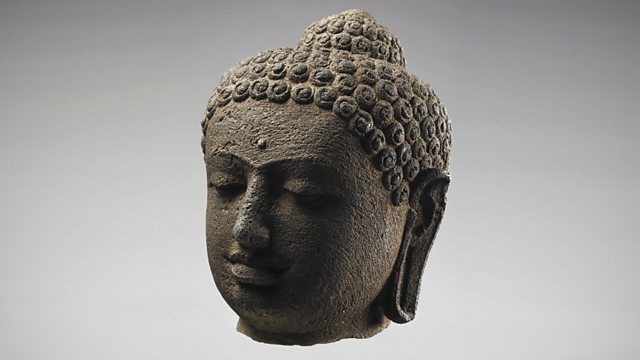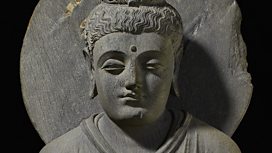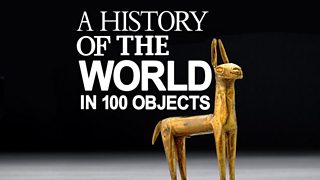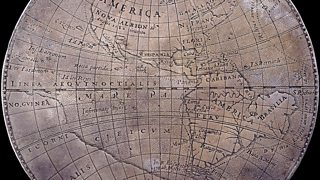Borobudur Buddha head
A new history of humanity as told through one hundred objects. Today, Neil MacGregor is with a head of the Buddha from Borobudur, one of the greatest monuments on earth.
A history of the World in one hundred objects arrives on the Indonesian island of Java. This is the series that offers a new history of humanity through the individual objects that time has left behind. These items are all in the British Museum and the series is presented by the museum's director, Neil MacGregor. Throughout this week Neil is tracing the great arcs of trade linking Asia, Europe and Africa around a thousand years ago. Today he has chosen a stone head of the Buddha that comes from one of the world's greatest monuments, the giant Buddhist stupa of Borobudur. Borobudur rises from a volcanic plain in the middle of Java, built from one and a half million blocks of stone and devised as an architectural aid to spiritual practice. Neil MacGregor reports from the various levels of Borobudur and describes the trade routes that brought Buddhism to South East Asia. He also explores the impact the discovery of Borobodur had on the founder of Singapore, Sir Stamford Raffles and his ideas about the importance of Javanese civilization. The anthropologist Nigel Barley celebrates the life and work of Stamford Raffles while the writer and Buddhist teacher Stephen Batchelor sums up the spiritual significance of Borobudur
Producer: Anthony Denselow
Last on
![]()
Discover more programmes from A History of the World in 100 Objects about religion
About this object
Location: Borobudur, Java
Culture: Buddhist World
Period: 750 - 850 AD
Material: Stone
��
This head of the Buddha originally comes from a statue in Borobudur in Java. Borobudur is one of the largest Buddhist monuments in the world, containing around 500 statues of the Buddha. The monument was built between AD 780 and 840 to resemble a mandala - a wheel-shaped symbol of the cosmos. Walking up the monument replicates the path to enlightenment, beginning at the base in the realm of desire and ending with the realm of formlessness at the top.
How did Buddhism spread to Java?
The style of the Buddha's head is similar to sculptures made in India and Sri Lanka. Both Buddhist and Hindu monuments were built in Java at the time of Borobudur and the Indian language of Sanskrit was used on inscriptions. Buddhism and Hinduism came to Indonesia and other parts of South East Asia from India. There were long established trading contacts between South East Asia and India, reaching back before AD 1, with merchants trading spices and other goods by sea. This trade also linked Java with China.
Did you know?
- Borobudur was rediscovered in 1815 by Sir Stamford Raffles, the founder of Singapore
Stamford Raffles
By Nigel Barley, anthropologist
��
We know Stamford Raffles nowadays as the founder of Singapore, which he did in 1819, and I think it’s significant that he did that in the face of explicit orders to the contrary and not to found any settlements. He was a man who knew his own mind, who was very determined, who had mastered the art of ignoring orders from London, and it’s not surprising that we associate him primarily with Singapore, but of course his real love was Java. And it was Java that he fell in love with and that he saw as a great civilisation.
He was a totally unrepentant imperialist, but he was unusual perhaps, in that he thought the justification for empire was the well being of local people. He also had a great moral force. He, if you like, became the acceptable face of imperialism in Asia, so that whenever the British were considering doing something particularly shady, people would raise as an argument ‘Well Stamford Raffles wouldn’t have approved’ and whenever the British were surprisingly acting rather well for once, they would immediately say ‘in the heritage of Stamford Raffles we propose’ so he actually made the British behave rather better in the far east than they might otherwise have done.
I would suggest why Raffles seems so very modern to us, because he was actually an eighteenth century man who leaked into the nineteenth century. He believed in all those eighteenth century things like the universality of man, reason, progress - that’s why he thought that civilisation could be found anywhere, it didn’t have to come with a white face and that was very unusual for the people around him.
He had a lot of detractors, a lot of enemies in the East India company, he had a lot of nicknames, they called him Sir Knight, they called him the golden sword, he was very much out of tune with the East India Company. He was also, surprisingly for a man that founded the great trading nation of Singapore, the world’s worst businessman - everything he did lost money.
A clear state of mind
By Stephen Bachelor, Buddhist teacher and writer
��
The Mandala is almost a symbolic representation of the cosmos itself. It mirrors the structure of the phenomenal world as understood by Buddhists at that time which consists on the basic level of the world of sensuality, and at Borobodur the base of the stupa represents the sensual world, the world of action, the world of trouble, the world of conflict.
As you rise up the various levels of this three-dimensional mandala you come to the next layer which is that of the realm of pure form, and the four main galleries around which you walk on the stupa at Borobodur represent this rather more purified formal realm where the life of the Buddha is depicted on the friezes.
But when you get to the upper level of the monument you suddenly find yourself without any forms at all, you just have the bare stonework and you have a dome, and then the central, uppermost crown of the monument has no image in it whatsoever. Whether that’s simply accidental, whether the image has been stolen, we just don’t know, but it conforms with the idea of moving as one rises in one’s spiritual practice from a kind of rooted-ness in the sensory confused world of passion and suffering and one rises through purer forms until one reaches a formless realm where one has somehow liberated one’s mind from all those things that have somehow caught it up in the messiness of life and has achieved a perspective. When you are at Borobodur you are standing on this great monument, you can see the entire world around you, beneath you, it’s an enormous experience of spaciousness, of freedom, and a far vaster perspective – a clear state of mind.
Sun, sea and the sacred
By Tom Hall, contributing editor, Lonely Planet
��
Borobudur stands with Angkor in Cambodia, Lalibela in Ethiopia and Istanbul’s Hagia Sophia, among the finest treasures of the world’s religions. With the growth of mass travel these and other temples and churches have become more than places of pilgrimage for the faithful. Tourists come to these places as well as believers – often in great numbers.
The appeal is obvious. Borobudur, lost for centuries to the jungle and volcanic earth, today towers over a beautiful landscape of rice paddies and tropical forest.
The stupa manages to retain a sense of space and peace even when thronged with the visitors who come here at holiday time. It’s considered an essential stop for anyone who visits Java, whether jaunting from nearby Yogyakarta or moving slowly through the island heading for Bali and paradise islands beyond. It remains - far more so than many holy places around the region and the world - a place of pilgrimage and prayer.
Reactions from visitors are inevitably mixed. Indonesia attracts a wide spectrum of visitors from around the world, from Korean package tour groups to Australian surfers.
Borobudur for some is, inevitably, another box to tick on the way to the beaches of Bali and beyond. For others, it’s the start – or continuation – of discovering what inspires the sacred places of the world.
Mass tourism brings mixed blessings to places like Borobudur. World fame and interest can spotlight conservation issues, but tens of thousands of tourists descending on the monument can bring its own challenges.
But for those who can visit, sites like Borobudur become more than former homes of long-dislocated fragments. They become real places with a place in modern society, and visitors hopefully gain a connection to and curiosity for the past, and an understanding of the value of preserving special places for future generations.
Transcript
Broadcasts
- Thu 24 Jun 2010 09:45���˿��� Radio 4 FM
- Thu 24 Jun 2010 19:45���˿��� Radio 4 FM
- Fri 25 Jun 2010 00:30���˿��� Radio 4
- Thu 24 Jun 2021 13:45���˿��� Radio 4
Featured in...
![]()
Religion—A History of the World in 100 Objects
A History of the World in 100 Objects - objects related to religion.
Podcast
-
![]()
A History of the World in 100 Objects
Director of the British Museum, Neil MacGregor, retells humanity's history through objects





